Drifting Down the Nile
We have three options. The most luxurious is the dahabiya, a traditional wooden boat with two sails. It’s like a floating private resort, with maybe ten air-conditioned cabins, ensuite bathrooms, an open deck, and a small crew who does everything including cooking the meals. Although its sails aren’t perfumed like Cleopatra’s were, it’s the closest we could get to sailing the Nile like she did.
Another choice is the felucca, a basic traditional sailboat. No private cabins, no washrooms. It holds six to ten passengers who share the mattress-lined open deck for eating, lounging, and sleeping. A support boat with bathroom facilities may join the felucca while it’s moored for the night. Or not -- in which case there’s the Nile itself or the riverbank.
Then there’s the riverboat, a floating hotel with about a hundred air-conditioned cabins, ensuite bathrooms, a dining room, bar, and roof deck with swimming pool. This is the Goldilocks option in terms of comfort and cost. We’ll be on this one, okay?
In Upper Egypt, most riverboats sail between Aswan and Luxor -- a mere 220 kilometers apart -- languidly over three or four days, mooring now and then to let passengers visit ancient monuments on the way. Overnight, everyone and everything goes to sleep – passengers, crew, engines – with the boats huddling together four-or-five-deep, their main doors aligned. When it’s time to disembark, the boats’ doors open on both sides, creating a straight corridor for everyone to pass through all the way to the ramp and on to the street. Same thing at boarding time.
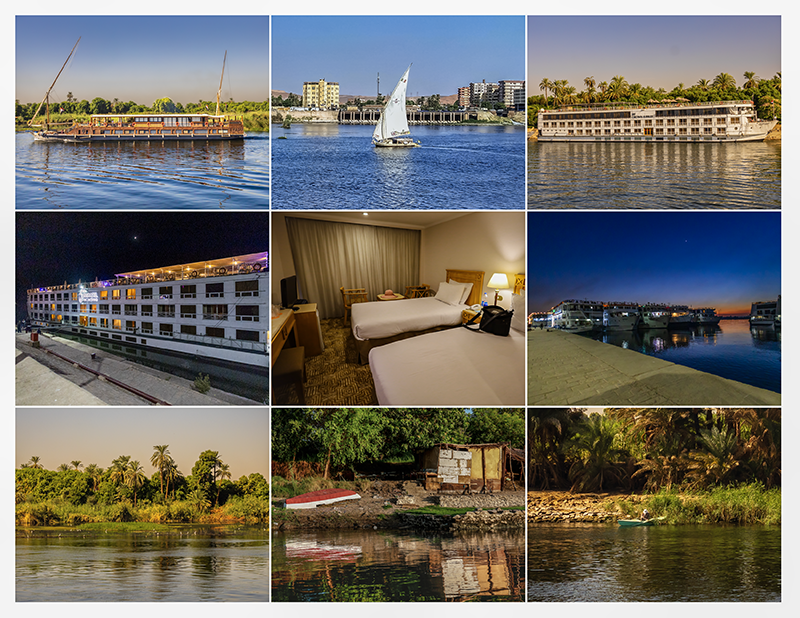
Top row, from left: Dahabiya, felucca, riverboat.
Middle row: The riverboat I took; the cabin I shared with a friend; riverboats docked side by side during the night. Bottom row: Views from the boat. (Photos by Odette Foronda)
Last time, I took you along to visit some royal tombs and mortuary temples in the city of the dead, on the Nile’s west bank. This time, we’ll check out some cult temples, which were built as houses for the gods. Because they were meant for use by the living, they are mostly on the east bank.
Each of Egypt’s cult temples focused on at least one god among the hundreds worshipped. At the heart of each temple was a sanctuary, the holy of holies, where the main god (his or her statue, at least) resided. Only the ruler and high-ranking priests were allowed inside. If other gods were worshipped in that temple, they had their own sanctuaries. Around the sanctuary were courts, halls, and various rooms. Within the temple walls, daily rituals and offerings were performed by priests acting on behalf of the ruler. During festivals and special occasions, the ruler himself performed the rituals. The general public was rarely allowed inside.
A temple’s interior was decorated with reliefs of pharaohs interacting with the gods, making offerings, and in return receiving more power and stability. Some carvings were procedural manuals for priests, with festival calendars and papyrus library catalogs. If a ruler wanted to affirm his divinity, he’d have reliefs depicting his conception and birth, with scenes involving one of his earthly parents and his chosen parent god.
On the other hand, the outside walls (pylons) served as billboards for royal propaganda and press releases: scenes showing the ruler as a superhero crushing the enemy in battle, dragging home the loot and prisoners of war, and presenting them to his patron gods.
Karnak
Let’s start with what’s regarded as the greatest of Egypt’s ancient temples – Karnak, which is in the city of Luxor.
Karnak was founded about 4,000 years ago, by the Middle Kingdom pharaoh Senusret I of the 12th dynasty. Over the following 2,000 years, succeeding pharaohs erected more structures, finished or repaired some, tore some down and reused the rubble, or usurped previous ones by superimposing their signatures over those of their predecessors. The New Kingdom (1580-1085 BC) saw a building frenzy that transformed Karnak into the largest religious complex in the ancient world.
Today, the Karnak complex covers an area of about four kilometers square, so brace yourself for a lot of sweaty walking under the punishing Egyptian sun. It’s a confounding jumble of ruins, and even if we walk in there with an Egyptologist like our friend Mac, it won’t be easy to make sense of what we’ll see. But that’s fine. We won’t fully grasp everything, but the hypostyles and obelisks will make for great photos. So, bring some water and a camera, and let’s go.
Karnak was built as the capital temple of the god Amun -- the god of the sun and air, the supreme god – as well as his wife, Mut, and their son, Khonsu. When the temple was four centuries old, Hatshepsut of the 18th dynasty built more structures and two obelisks. On the temple walls, she added depictions of the Opet Festival, the biggest event of the year, when the deities’ statues were paraded in boat-shaped vessels called barques to Luxor Temple two kilometers to the south. At Luxor, the pharaoh was ritually reborn and re-crowned by Amun (via a priest), thus re-legitimizing his divine right to rule. The feasting and free beer that followed lasted as long as three weeks.
Now, Hatshepsut started as a regent when her nephew-stepson Thutmose III inherited the throne as an infant. She later became co-ruler. After her death, Thutmose III tried to erase references to his stepmom. He also erected some buildings and obelisks, one of which has been at Saint John Lateran in Rome since the 16th century.
The beat went on. Amenhotep III demolished the original structures and built a processional way connecting Karnak to Luxor Temple. Akhenaten, his successor son, overhauled the system by recognizing only one god, banishing the rest, and moving his capital elsewhere. When Akhenaten’s son, the famous boy king Tutankhamun, came to the throne, he restored the polytheistic order and moved the capital back to Thebes (today’s Luxor). He reopened Karnak and added decorations. From his father’s temple, he took several sphinxes that had the heads of his parents Akhenaten and Nefertiti, re-carved the heads as ram’s heads, and then lined them along the Karnak-Luxor processional that his grandpa had built.
Uh, for these royals who liked to write in stone, nothing was really written in stone, no?
“In Upper Egypt, most riverboats sail between Aswan and Luxor -- a mere 220 kilometers apart -- languidly over three or four days, mooring now and then to let passengers visit ancient monuments on the way. ”
Horemheb, the last 18th dynasty ruler, did even more to eradicate Akhenaten’s memory. Plus, he tore down some of Tut’s work. Over the references to Tut that remained, he superimposed his name. If you see carvings deeper than the surrounding ones, that’s a good sign that someone had usurped a predecessor’s work.
The succeeding dynasty, the 19th, also saw a lot of building activity. Seti I built the largest hypostyle hall in Egyptian history. His son Ramesses II (the Great) finished his dad’s work and added to it, at times replacing his dad’s image with his.
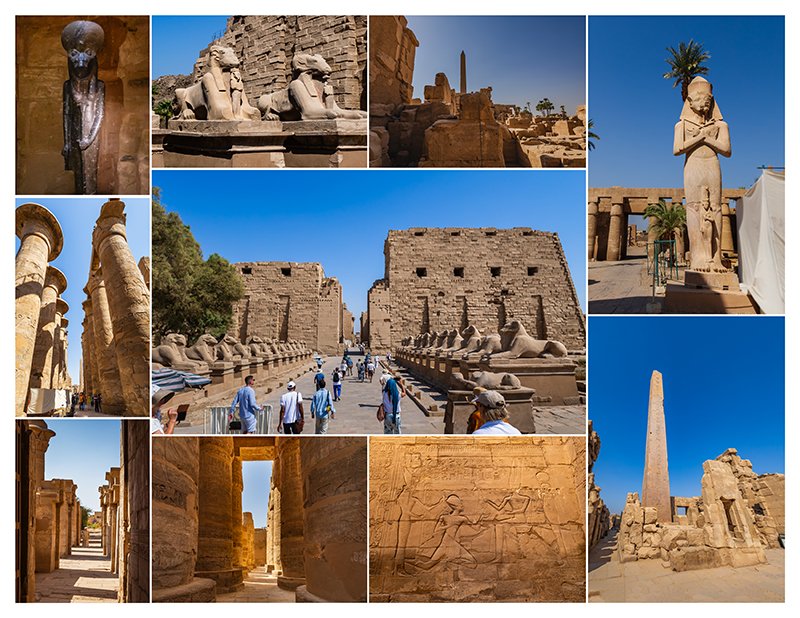
Karnak Temple complex. Middle photo: A row of sphinxes leading to the front pylon.
Other photos, clockwise from top left: Statue of the god Ptah in one of the many sanctuaries. Ram-headed sphinxes cradling statuettes of Ramesses II. A view of the jumble of ruins. A colossus of Ramesses II with a smaller statue of his queen Nefertari at his feet. One of Hatshepsut’s obelisks. Relief of a kneeling Ramesses II receiving blessings from Amun. Great Hypostyle Hall. Entrance to the Temple of Ptah. More columns at the Great Hypostyle Hall. (Photos by Odette Foronda)
Luxor Temple
If you find the Karnak ruins quite confusing, worry not. Luxor is easier to figure out. More beautiful, too, especially because the Avenue of Sphinxes that leads to Karnak has just been restored. We’ll go there at sundown; it’s just a ten-minute drive from the cruise port.
Luxor Temple was built as Amun’s southern house by New Kingdom pharaohs, notably Hatshepsut and Tut’s grandpa Amenhotep III.
Ramesses II did a big makeover, building the entrance pylon with his four colossi and obelisk. There used to be two obelisks, but one was given to France in the 19th century by Muhammad Ali Pasha who ruled Ottoman Egypt at that time. In return, France gave him a clock. France installed the obelisk at the Place de la Concorde in Paris, while Muhammad Ali placed the clock in his Cairo mosque.
On the outer pylon, Ramesses II put scenes of his glorious victory in the Battle of Kadesh (near today’s Aleppo). Historians, however, say he lost, or at best, it was a stalemate. He also usurped some of Amenhotep III’s work inside, in addition to decorating a court with even more of his statues.
The holy of holies was rebuilt by Alexander the Great and still carries reliefs bearing his image interacting with the gods. After Rome took over the rule of Egypt, its legionaries used the area as a camp and converted Alexander’s chapel into an imperial room. Traces of colored Roman frescoes remain. During the Christian era, this room was used as a Coptic church. With the introduction of Islam, the Abu Hagagg Mosque was built in the complex, and it still stands there today.
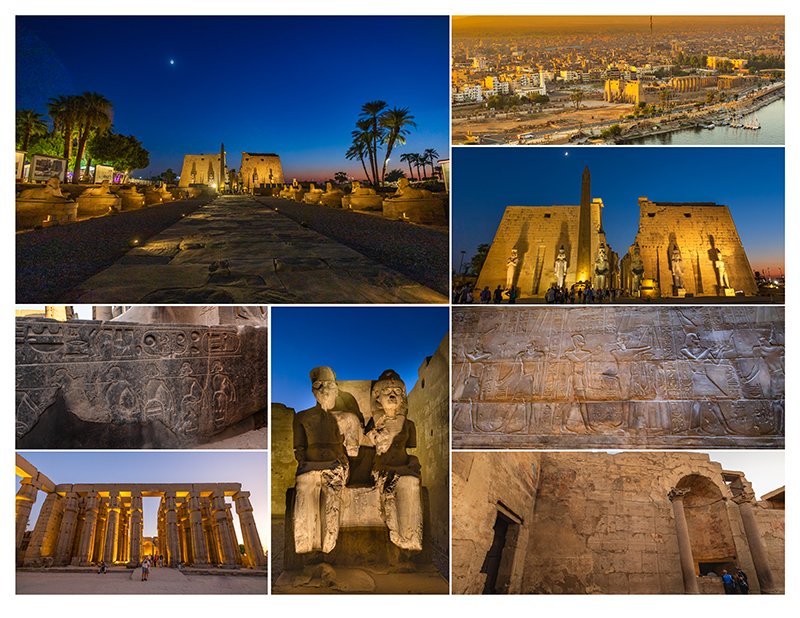
Top row: Luxor Temple viewed from the Avenue of Sphinxes and from the air; the front pylon sits behind giant statues of Ramesses II and has the now-faint scenes of the Battle of Kadesh.
Middle row: Prisoners of war tied together by the neck; Alabaster statues of Tutankhamen and his wife; Alexander the Great interacting with an ithyphallic god.
Bottom left: Colonnade of Amenhotep III; Bottom right: Amun’s shrine later converted to a Romans shrine and then a church (Photos by Odette Foronda)
Abu Simbel
You think Luxor screams Ramesses II? Let’s check out Abu Simbel.
We’ll need to leave Aswan at 4:30 a.m. in order to make it to Abu Simbel before it gets too hot. Our boat crew will pack our breakfast in bags, and for over three hours, we’ll be dozing off on the highway that cuts through the vast, hypnotizing Western Desert.
In the far south of Egypt, a mere 20 kilometers from the border with Sudan, Ramesses II hewed two temples out of a sandstone cliff. Why so far from his capital of Thebes? What better way to show his absolute power to the recently-conquered Nubians than to build an awe-inspiring temple in their midst?
There are two temples. The Great Temple was dedicated to the three gods Amun-Re, Re-Horakhty, and Ptah. Outside and inside, it is dominated by statues and images of Ramesses II, including scenes from the Battle of Kadesh. The sanctuary holds seated statues of him and the three gods. Each year on February 22 and October 22, the sun aligns with the entrance corridor and illuminates the sanctuary for some 20 minutes. What about these dates? They are neither equinoxes nor solstices. Some scholars believe they mark the birthday and coronation day of Ramesses II.
A smaller temple is dedicated to Ramesses II’s favorite wife, Nefertari, and the cow goddess Hathor. The façade is adorned with alternating statues of the royal couple. This is probably the only case where a queen is honored with a temple and where her statues are as large as the king’s.
The temples were buried in sand for centuries and were discovered only in the early 1800s by a Swiss explorer who named them Abu Simbel after the Nubian boy who served as his guide. With the building of the Aswan Dam in the 1960s, the resulting Lake Nasser threatened to submerge several ancient structures in the area, Abu Simbel among them. UNESCO then embarked on an international donation campaign to rescue the monuments. For four years, the Abu Simbel temples were painstakingly cut up, and then the blocks were numbered and put back together on a higher location near the original site.
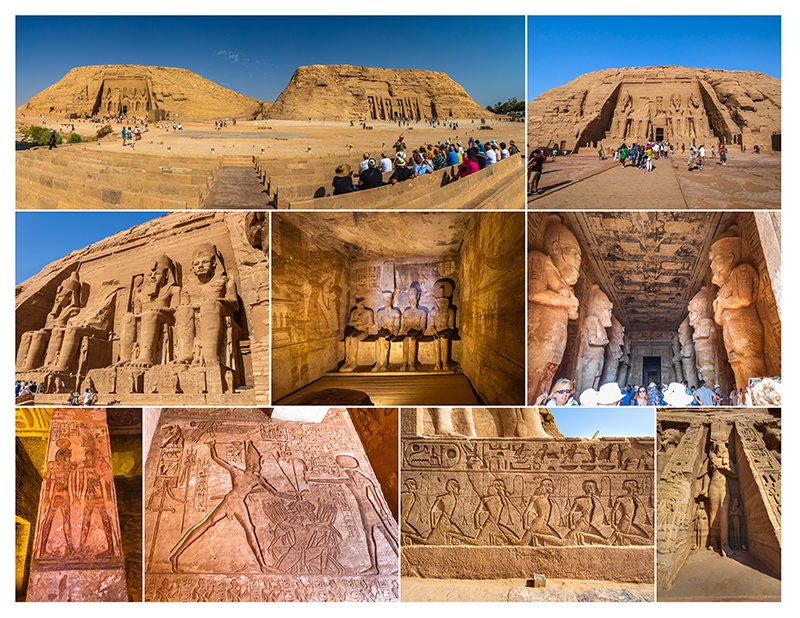
Top row, from left: The two temples of Abu Simbel. A closer view of The Great Temple.
Middle row: The façade of the Great Temple with four colossi of Ramesses II and small statues of his family at his feet; the sanctuary with statues of Ramesses II with three gods; the main corridor of the Great Temple.
Bottom row: First three are reliefs in Great Temple, two of which feature the Battle of Kadesh. The rightmost photo is a statue of Nefertari on the façade of the Small Temple. (Photos by Odette Foronda)
The Western Desert
About 400 kilometers to the west of Abu Simbel, very near the Libyan border, is the Cave of Swimmers. You’ve seen the 1990s film The English Patient, yes? Ralph Fiennes and Kristin Scott Thomas. The scene where he pulls her out of a plane wreck and walks to that cave cradling her in his arms. Where she says, Of course, you idiot… I’ve always loved you (and at which point I always start bawling). Although that scene was not shot in Egypt but in a film set, tourists have visited the real Cave of Swimmers on account of the movie and have caused substantial damage to its Neolithic drawings. Oh dear.
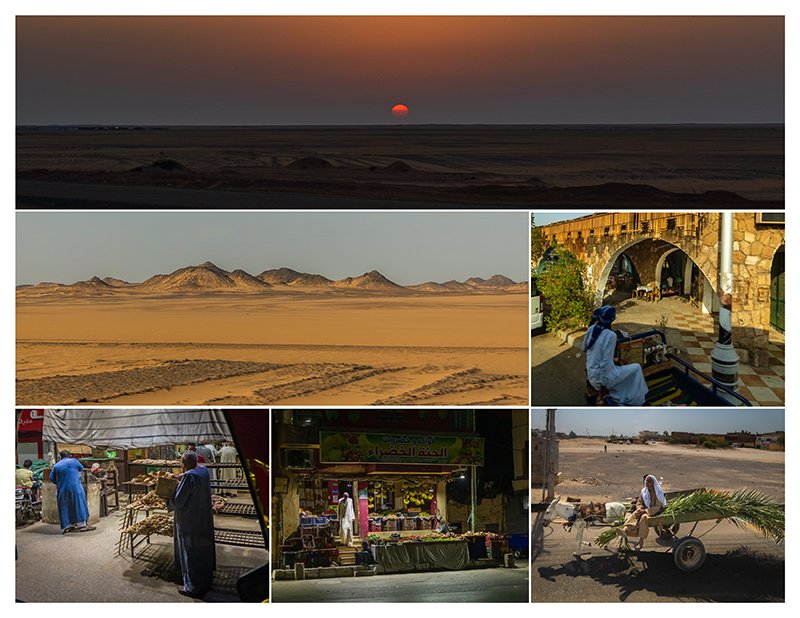
Top row: Sunrise on the Western Desert.
Middle row: Scenes from the Western Desert.
Bottom row: Scenes from villages around Luxor. (Photos by Odette Foronda)
Philae
UNESCO was able to rescue 20 or so ancient monuments from being submerged by Lake Nasser. Philae, like Abu Simbel, is among the more famous ones. Stone by stone, it was relocated to Agilkia Island where it stands today. We’ll take a short boat ride from Aswan to get there.
In the fourth century BC, Nectanebo I founded what was to be the last native dynasty to rule ancient Egypt, the 30th dynasty. He erected Philae Temple on Philae Island, a site sacred to the cult of the goddess Isis. Most later additions and renovations were done by the Ptolemies, the Greek dynasty that succeeded Alexander the Great and ruled over Egypt for three centuries until Cleopatra’s death in 30 BC.
When the Ptolemies came to power, the Great Pyramid of Giza was over 2,200 years old, Karnak 1,500, and Luxor 1,000 – all ancient in their eyes, the way we might regard the Roman Pantheon today. They did not drastically remodel existing temples. As well, they adopted Egyptian culture and religion. At Luxor, for instance, we see Alexander the Great styled like a native Egyptian pharaoh in dress and manner. Like the pharaohs before them, they erected temples in honor of Egyptian gods instead of Greek ones. It helped that they found close associations with familiar gods -- like the Egyptian Amun to the Greek Zeus, Horus to Apollo, Isis to Aphrodite, and so on. They stuck to the Egyptian template: gods resided in sanctuaries, the temple interior held classified records, and the exterior wall was for press releases.
The Romans left their mark, too, with reliefs of Tiberius, Augustus, and Nero on the columns. In the fourth century, the Byzantines took over, forbade pagan rituals, and converted the temples into churches. Because the ancient Egyptians believed that power resided in the images of the gods and pharaohs, the Byzantines hacked out as many such images as they could. Traces of deliberate defacement are still visible in Philae and in some other ancient monuments.
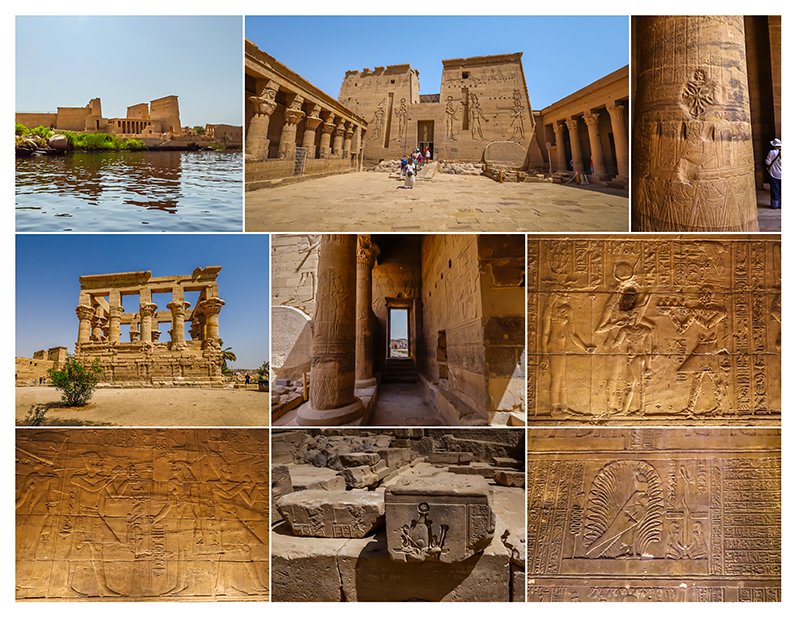
Top row: Philae Temple on its new location on Agilkia Island; inner colonnade; a Coptic cross on a column.
Middle row: Pharaoh’s Bed built by Trajan; view from the interior of one of the buildings; relief with a defaced Isis.
Bottom row: Details of reliefs and ruins (Photos by Odette Foronda)
Kom Ombo
The Ptolemies built Kom Ombo in the second century BC, dedicating it to the crocodile god Sobek. Back then, menacing crocodiles lived all over the Nile. The dam has since trapped them upstream, so they no longer terrorize the population downstream.
The temple is right on the riverbank. The river has eaten up some of its parts but it’s still largely intact. We’ll see it as our boat sails toward the dock. During the short walk to the temple, we’ll have to deal with a horde of vendors pushing their wares in our faces. We’ll have gotten used to the drill and politely say, La shukran as we try to chase Mac who walks quite fast. Very useful phrases, Shukran and La shukran. Thank you; No, thank you.
Apart from the temple, we’ll find a museum with mummified crocodiles and other artifacts. There’s also a deep well with stairs. It’s a Nilometer, a structure used to measure the water level during Nile’s the annual flooding before Aswan Dam was built.
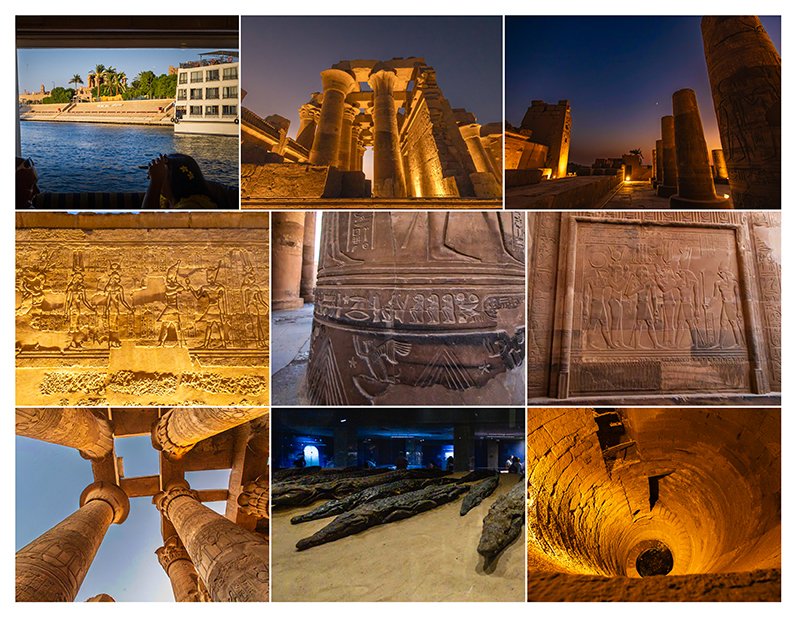
Kom Ombo Temple.
Top row: Views of Kom Ombo, the leftmost one from the riverboat.
Middle row: Detail on interior walls and column.
Bottom row, from left: View of the colonnade; crocodile mummies; Nilometer
(Photos by Odette Foronda)
Edfu
We’re going to Edfu at daybreak. Once we get off the boat, all of the town’s coachmen will be waiting for us with their horses and carriages. We’ll get on a carriage for the two-kilometer ride to the temple. Clop-clop…the sky starts to glow to our right…the bakers and farmers are fixing bread and produce on their shelves… Clop-clop-clop…I’m back home in 1960s Laoag, sitting on a calesa (horse-drawn cart) next to my mom, a bag of goodies on her lap…I lean over to her and sniff the ripe mangoes to drown out the smell of horse manure….
Edfu Temple is one of the best-preserved ancient monuments in Egypt. It was established by the Ptolemies in 237 BC and later added to by succeeding pharaohs. It stars the falcon god Horus, the god of kingship. When the Byzantines forbade pagan worship in the fourth century, they defaced many of the reliefs. Some say the blackened ceiling could be the result of an attempt to even burn the temple altogether.
Through time, the temple was buried by shifting desert sands and silt from the Nile. Eventually, locals built their homes on the now-higher ground, unwittingly preserving the temple buried underneath. What we see today is what archaeologists have unearthed after the site was discovered in the late 1800s.
Many Ptolemaic temples had a Mammisi, or birth house, a separate building off to the side of the front pylon. Here, the principal god’s divine children as well as the pharaoh’s kingship were ritually reborn each year.
There’s a theory that Cleopatra gave birth to Caesarion, her love child by Julius Caesar, in Edfu’s Mammisi. However, it is not fully substantiated. What is certain is that the little statue at the feet of Horus by the front gate is that of Caesarion or Little Caesar. He is sometimes listed as the last Ptolemaic ruler of Egypt, but he did not really rule, because soon after his mom’s death, Rome’s Octavian quickly took over Egypt and had him killed.
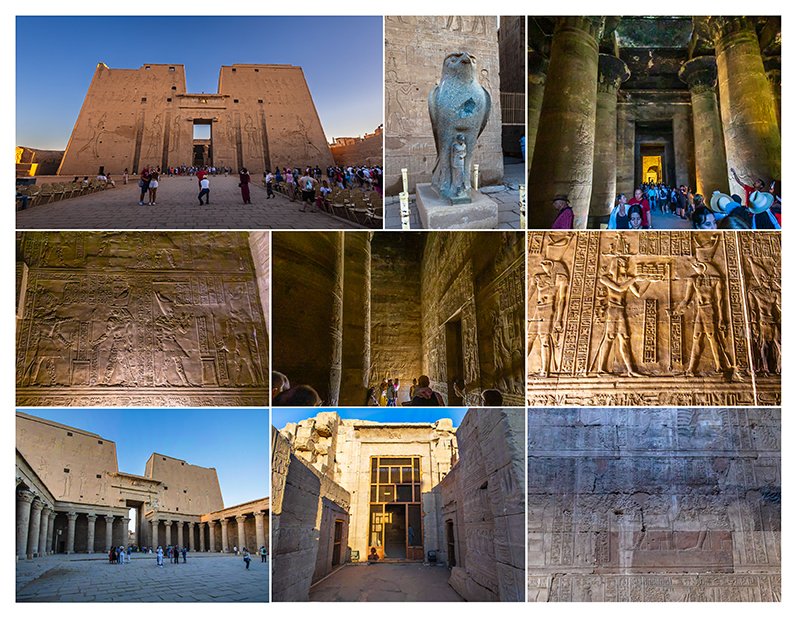
Top row, from left: The front pylon of Edfu Temple showing Ptolemy XII crushing the enemy; one of two statues of Horus guarding the main gate, with Little Caesar at its feet; temple interior with blackened ceiling.
Middle row: Interior of the main temple, with reliefs showing the falcon god Horus.
Bottom row: Inner court; the Mammisi; relief of birth scene in the Mammisi (Photos by Odette Foronda)
They’re rude, a friend will say about Egyptians before we go. They don’t want you taking their pictures, we’ll also hear. So, we’ll pack less flashy camera gear and make sure not to shoot in wild abandon. The times we’ll make eye contact with locals, we’ll gesture if it’s okay to shoot and will be rewarded with smiles and poses. We’ll click on the fly, and then put our hands over our hearts or blow them kisses, then we’ll hurry on lest we lose sight of Mac.
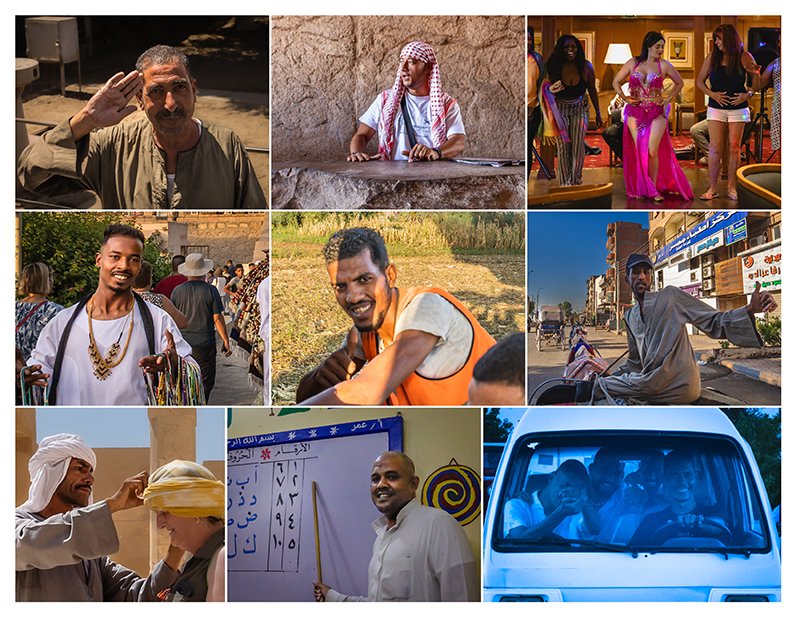
Top row, from left: A worker at Esna Lock; our Egyptologist guide, Mahmoud Eid Abdelkader (Mac), whom I bugged while writing this piece, channeling his inner Ramesses II at a Karnak altar; eEvening entertainment on the boat.
Middle: A vendor at Kom Ombo; one of our hot air balloon crew; our Edfu coachman.
Bottom: A vendor fitting a turban on a tourist; a Nubian teacher at Gharb Sohel trying to teach us Arabic; men in a van driving behind the army-type jeep I was on in South Sinai (outside the boat cruise) (Photos by Odette Foronda)
Well! More temples? No, no more. Aren’t you tired yet? Let’s just get back on the boat and watch rural Egypt go by. Before dinner, we can watch Re sail into the underworld to battle with Apophis through the night, confident that he’ll win and emerge again in the morning. We could go for dinner at a Nubian village, too, if you want. Or else join the boat’s after-dinner party. Belly dancing, galabiya costume party? Both?
While you party, I will run up to the roof deck. I will lie down on a lounge chair and gaze straight up at the stream of Hathor’s milk as it sparkles and flows, sparkles and flows, reflecting the Nile the way it has for ages. I will lie there wondering why it floats instead of spilling down to me. The breeze will be nice and warm. Come find me there in the morning.

Top row: Views of Gharb Sohel, a Nubian village close to Aswan, where we had dinner one night.
Middle row: Views of the river from a small boat.
Bottom row: Vendors making a sale to passengers on the riverboat’s roof deck. They hook up their boat to yours and spread out their goods. If you show any interest in anything, they hurl two bagged items up to you. If you’re sold, keep the item you want then put your money in the other bag and throw it down to them. (Photos by Odette Foronda)

Sunset and Milky Way viewed from the riverboat’s roof deck. (Photos by Odette Foronda)
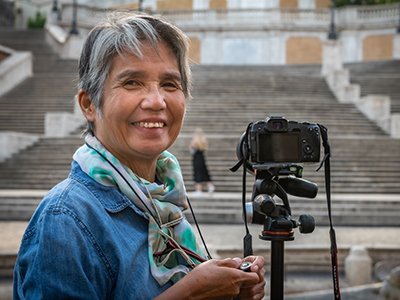
Odette Foronda is a mother of four, grandma of two pretty teenage girls and cute twin three-year-old boys, based in Toronto. Now retired from years of working in the numbers field, she’ll travel as far as her Ilocano purse will allow. She has published 11 books of her travel photos and stories (https://www.blurb.com/user/odettef).
More articles from Odette Foronda






No comments:
Post a Comment